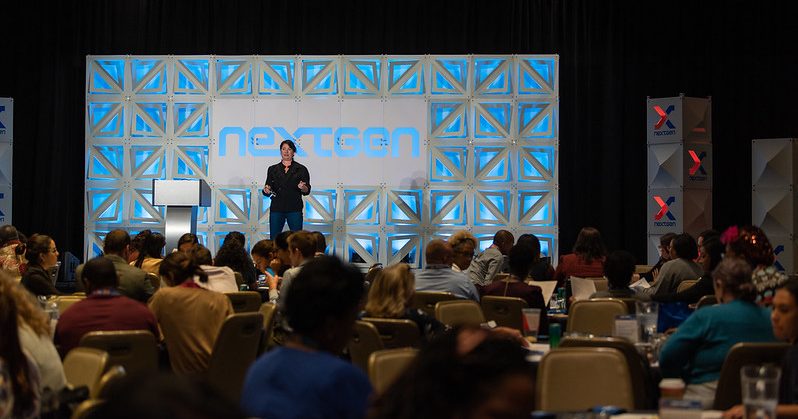There’s growing interest in government — from the White House down — to develop and expand the use of artificial intelligence on the battlefield, in hospitals and in other places where rank-and-file feds are serving the public and driving the mission.
But as the AI conversation evolves in government, there’s a recurring question and concern that is regularly raised: How are agencies preparing the workforce, and will AI take jobs? This issue was the common thread discussed during panel sessions at the General Services Administration’s (GSA) Jan. 29 AI event, which spanned topics including strategic use of AI across departments, how AI powers better analytics and improves customer service, and how to write requirements for emerging technology.
While moderating a panel on using AI strategically across the enterprise, Carlton Shufflebarger, Acting Director of IT Services at GSA’s Office of Information Technology Category, summed up the issue at the heart of successful AI adoption in government: people.
“How do we build the workforce capabilities, the workforce skills?” he said
Shufflebarger said that for agencies and their industry partners to embrace AI on a large scale, they need to grow the talent to develop and implement AI. “We need to grow and develop that expertise internally, in addition to supplementing it with new hires,” Shufflebarger said.
This has implications for training and development in government. Successful AI adoption will require agencies to rethink how they train adult learners to grasp new topics and skills. For example, Beth Killoran, GSA’s Deputy Chief Information Officer, said she is considering how short, YouTube-style videos and podcasts could be training tools for employees to learn at their own pace in digestible chunks.
AI adoption also hinges on how agencies approach change management, Shufflebarger added. Not only must agencies equip their workforce, but they must also find ways to break down resistance so that employees don’t see AI as a threat but rather as an opportunity to enhance their career or mobility.
And that’s where the disconnect often lies. Employees are told that tools such as AI are not taking jobs but taking work — specifically the manual or repetitive tasks that are considered low-value work. But that messaging is not always resonating with employees who will be implementers of the government’s AI rollout.
Employee and Executive Buy-In Are Key
In June 2019, the Office of Personnel Management released a memo providing guidance for agencies on how to classify occupational titles for data scientists. The guidance authorized agencies to “use a parenthetical of (Data Scientist) along with the occupational title for positions that perform data science work as a major portion of the job, and not as a collateral duty, for example, Statistician (Data Scientist).”
Rebecca Hutchinson, Big Data Leader in the Economic Indicators Division at Census, noted the guidance around data scientist roles, adding that her division is focused on training the existing workforce in data science.
“We are the Census, so we do math,” Hutchinson said. “We have a lot of statisticians.”
A year and a half ago, her division rolled out a data science training program through Coursera and welcomed all staff to apply. Through the program, they could learn Tableau, GIS (geographic information systems), and R and Python programming languages used for data analysis.
Training and getting your existing staff excited about these things will help quite a bit,” she said. This is especially true when seeking buy-in from employees. When they experience these tools for themselves, they start to believe that what they’re being trained to use can help and improve their jobs. As people see the success of using these tools in their everyday work, that has helped fuel AI and machine learning adoption and new ideas from employees on practical use cases.
Hutchinson acknowledges there will be employees who enjoy manual work and may not readily embrace AI. But there is a role they play as well. In particular instances, such as applying codes to data, not all of that work can be easily automated.
At the Agriculture Department (USDA), Chief Information Officer Gary Washington credited the top-level support and use of data as a key driver in AI adoption. “You can argue that data is where mission and IT meet together,” he said.
GSA’s Killoran echoed those sentiments. “This can’t be a push by the IT organization pushing it [AI] on the business,” she said. “It has to be two-way.”
This is not just about senior IT and business leaders sharing ideas and educating themselves on the technology. This same collaborative effort must trickle down to the grassroots level, to the frontline employees and those charged with carrying out the mission.
Killoran said that GSA has half-dozen AI pilots, and they are driven by people from the business side of GSA. They came to IT asking how they could be more efficient. She shared this hypothetical scenario of how that connection might play out: Let’s say a business unit doesn’t have enough time to complete a particular task or their customer experience is lagging. Using data to assess the situation, a determination can be made on whether AI and machine learning could be a good fit to fill gaps.
“This is not, ‘The Borg is coming to assimilate you,’” Killoran said, referencing the alien group on Star Trek that was determined to transform people by force.
Ultimately, what agencies like GSA are hoping to do is tap into the groundswell and collective wisdom across government and industry. GSA is helping lead the charge to develop artificial AI expertise across the federal workforce through a cross-governmental community of practice and knowledge sharing with industry.
The hope is that community will feed into a larger initiative, aimed at embedding AI professionals within agencies to help improve government services to the public, Anil Cheriyan, Director of the GSA’s Technology Transformation Services (TTS) office, said during a White House AI summit last September.
“That is all about accelerating and driving and scaling the execution of AI across the government,” Cheriyan said.





This is a thought-provoking article. I wonder if agencies talking about how AI won’t take jobs are engaging in wishful thinking.